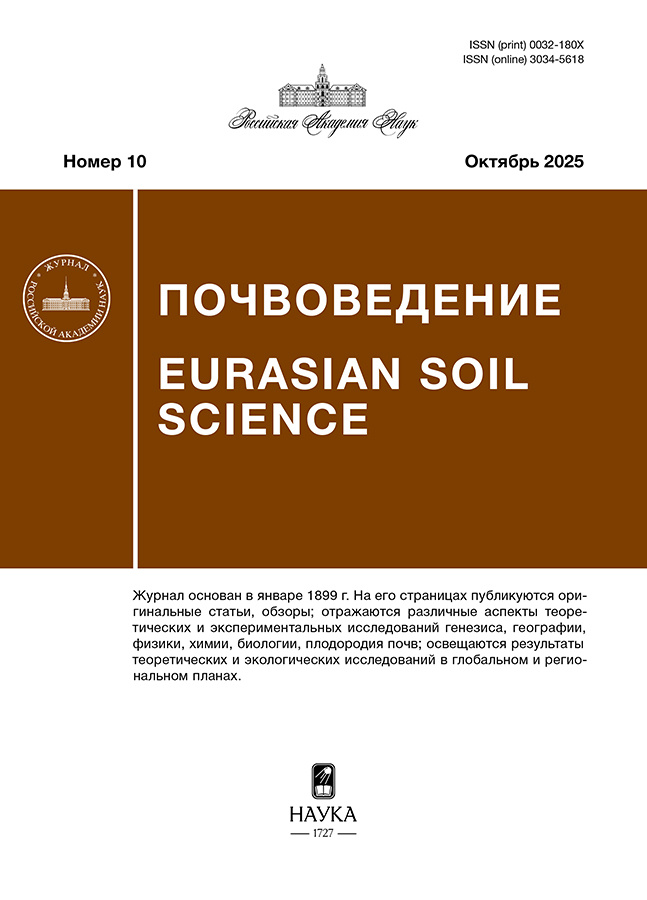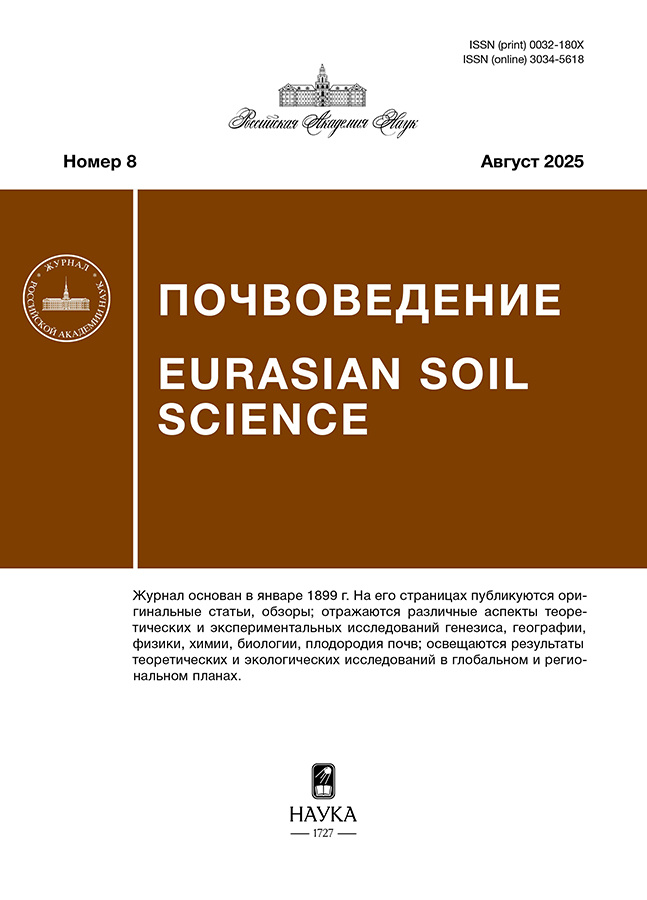Мерзлотные глееземы Приполярного Урала: морфолого-криогенное строение, температурный режим и физико-химические свойства
- Авторы: Жангуров Е.В.1, Каверин Д.А.1, Дымов А.А.1, Старцев В.В.1
-
Учреждения:
- Институт биологии Коми НЦ УрО РАН
- Выпуск: № 8 (2025)
- Страницы: 1008–1024
- Раздел: ГЕНЕЗИС И ГЕОГРАФИЯ ПОЧВ
- URL: https://freezetech.ru/0032-180X/article/view/688107
- DOI: https://doi.org/10.31857/S0032180X25080039
- EDN: https://elibrary.ru/INNDUL
- ID: 688107
Цитировать
Полный текст
Аннотация
Исследованы особенности строения и свойств мерзлотных глееземов и торфяно-глееземов тундровых ландшафтов Приполярного Урала – наиболее южных минеральных почв с островной многолетней мерзлотой, особенно чувствительной к современным климатическим изменениям. В рамках исследования подробно рассмотрены морфологическое и криогенное строение, температурный режим, минералогический состав и физико-химические свойства сезонноталых и подстилающих многолетнемерзлых горизонтов. Маломощный сезонноталый слой почв характеризуется преобладанием торфяных горизонтов и значительным оглеением минеральных, в верхней части многолетнемерзлой толщи локализован высокольдистый переходный слой. В сезонномерзлых горизонтах выявлены массивные криогенные текстуры, в подстилающих многолетнемерзлых – шлировые и атакситовые. Торфяно-глезеем, в отличие от более холодного глеезема, характеризуется относительно мягким температурным режимом, что объясняется повышенной мощностью теплоизолирующего торфяного горизонта и большей высотой снежного покрова. Мерзлотные почвы Приполярного Урала приурочены к климатически-обусловленным экосистемно-модифицированным многолетнемерзлым породам. Выявлено, что преобладание крупнопылеватой фракции почв при близком подстилании многолетнемерзлых пород способствует значительной тиксотропности глеевых сезонно-талых горизонтов. Криогенно-литологическая неоднородность профилей в условиях субарктического гумидного климата горной страны обусловливает специфику строения и свойств глеевых мерзлотных почв Приполярного Урала.
Полный текст
Об авторах
Е. В. Жангуров
Институт биологии Коми НЦ УрО РАН
Автор, ответственный за переписку.
Email: zhan.e@mail.ru
ORCID iD: 0000-0002-4297-7536
Россия, Коммунистическая, 28, Сыктывкар
Д. А. Каверин
Институт биологии Коми НЦ УрО РАН
Email: zhan.e@mail.ru
ORCID iD: 0000-0003-2559-2340
Россия, Коммунистическая, 28, Сыктывкар
А. А. Дымов
Институт биологии Коми НЦ УрО РАН
Email: zhan.e@mail.ru
ORCID iD: 0000-0002-1284-082X
Россия, Коммунистическая, 28, Сыктывкар
В. В. Старцев
Институт биологии Коми НЦ УрО РАН
Email: zhan.e@mail.ru
ORCID iD: 0000-0002-6425-6502
Россия, Коммунистическая, 28, Сыктывкар
Список литературы
- Атлас по климату и гидрологии Республики Коми. М.: Дрофа, 1997. 116 с.
- Атлас почв Республики Коми / Под ред. Добровольского Г.В. и др. Сыктывкар: ООО Коми республиканская типография, 2010. 356 с.
- Геокриология СССР. Европейская территория СССР / Под ред. Ершова Э.Д. М.: Недра, 1988. 358 с.
- Герасимова М.И., Лупачев А.В., Губин С.В., Горячкин С.В. Положение мерзлотных почв в классификации почв России: проблемы и возможные решения // Сб. тез. Всерос. науч.-пр. конф. (Салехард–Лабытнанги, ЯНАО, Россия, 20–26 августа 2023). Сыктывкар: ИБ ФИЦ Коми НЦ УрО РАН, 2023. С. 277–279.
- Гончарова О.Ю., Матышак Г.В., Бобрик А.А., Москаленко Н.Г., Пономарева О.Е. Температурные режимы северотаежных почв Западной Сибири в условиях островного распространения многолетнемерзлых пород // Почвоведение. 2015. № 12. С. 1462–1473. https://doi.org/10.7868/S0032180X1500032
- Горячкин С.В. Почвенный покров Севера (структура, генезис, экология, эволюция) М.: ГЕОС, 2010. 414 с.
- ГОСТ 26262-84. Грунты. Методы полевого определения глубины сезонного оттаивания. М.: ИПК Изд-во стандартов, 1984. 6 с.
- Дымов А.А., Жангуров Е.В., Старцев В.В. Почвы северной части Приполярного Урала: морфология, физико-химические свойства, запасы углерода и азота // Почвоведение. 2013. № 5. С. 507–516.
- Жангуров Е.В. Разнообразие и диагностика криогенных процессов в почвах горной катены Приполярного Урала // Матер. Межд. Научн. конф. I Никитинские чтения “Актуальные проблемы почвоведения, агрохимии и экологии в природных и антропогенных ландшафтах”. Пермь: ИПЦ “Прокростъ”, 2020. С. 60–63.
- Жангуров Е.В., Королёв М.А., Дубровский Ю.А., Шамрикова Е.В. Почвы горного хребта Рай-Из (Полярный Урал) // Почвоведение. 2023. № 4. С. 417–432. https://doi.org/10.31857/S0032180X22601256
- Жангуров Е.В., Старцев В.В., Дубровский Ю.А., Дёгтева С.В., Дымов А.А. Морфолого-генетические особенности почв горных лиственничных лесов и редколесий Приполярного Урала // Почвоведение. 2019. № 12. С. 1415–1429. https://doi.org/10.1134/S0032180X19120141
- Игнатенко И.В. Почвы восточно-европейской тундры и лесотундры М.: Наука, 1979. 279 с.
- Каверин Д.А., Пастухов А.В. Температурное состояние почвогрунтов бугристо-мочажинных болот в зоне редкоостровного распространения многолетнемерзлых пород (Европейский Северо-Восток России) // Криосфера Земли. 2018. Т. XXII. № 5. C. 47–56. https://doi.org/10.21782/KZ1560-7496-2018-5(47-56)
- Каверин Д.А., Пастухов А.В., Новаковский А.Б., Биази К., Марущак М., Елсаков В.В. Влияние ландшафтных и климатических факторов на глубину сезонного протаивания в почвах бугристых торфяников (на примере площадки R52) // Криосфера Земли. 2019. Т. XXIII, № 2. С. 62–71. https://doi.org/10.21782/KZ1560-7496-2019-2(62-71)
- Кузнецова А.М., Кузнецов П.В. Выветривание полевых шпатов в разновозрастных иллювиально-железистых подзолах (Западные Кейвы, Кольский п-ов) // Почвоведение. 2003. № 12. С. 1474–1481.
- Конищев В.Н. Формирование состава дисперсных пород в криолитосфере. Новосибирск: Наука, 1981. 197 с.
- Лепорский О.Р., Седов С.Н., Шоба С.А. Роль промораживания в разрушении первичных минералов в подзолистых почвах // Почвоведение. 1990. № 6. С. 110–116.
- Лупачев А.В., Губин С.В., Веремеева А.А., Каверин А.В., Пастухов А.А., Якимов А.С. Микрорельеф поверхности многолетнемерзлых пород: строение и экологические функции // Криосфера Земли. 2016. Т. 20. № 2. С. 3–14.
- Мажитова Г.Г. Температурные режимы почв в зоне несплошной многолетней мерзлоты европейского северо-востока России // Почвоведение. 2008. № 1. С. 54–67.
- Мергелов Н.С., Таргульян В.О. Процессы накопления органического вещества в минеральной толще мерзлотных почв приморских низменностей Восточной Сибири // Почвоведение. 2011. № 3. С. 275–287.
- Оберман Н.Г., Борозинец В.Е. Урал. Геокриология СССР. Европейская территория СССР. М.: Недра, 1988. С. 301–324.
- Огуреева Г.Н. Ботанико-географическое районирование СССР М.: Изд-во МГУ, 1991. 188 с.
- Осадчая Г.Г., Тумель Н.В. Локальные ландшафты как индикаторы геокриологической зональности (на примере европейского северо-востока) // Криосфера Земли. 2012. Т. XVI. № 3. С. 62–71.
- Пастухов А.В., Каверин Д.А. Способ ручного бурения мерзлых горизонтов в почвах и верхнем слое многолетнемерзлых пород с одновременным отбором ненарушенных проб почвогрунтов. Пат. № 2673571 РФ.
- Полевой определитель почв России. М.: Почв. ин-т им. В.В. Докучаева, 2008. 282 с.
- Ривкин Ф.М., Власова Ю.В., Пармузин И.С. Закономерности изменения геокриологических условий в результате осадки мерзлых пород при оттаивании // Криосфера Земли. 2017. Т. XXI. № 6. С. 26–34.
- Рогов В.В. Основы криогенеза (учебно-методическое пособие). Новосибирск: ГЕО, 2009. 203 с.
- Русанова Г.В., Кюхри П. Почвы границы леса и горной тундры Приполярного Урала // Почвоведение. 2001. № 4. С. 409–417.
- Седов С.Н., Шоба С.А. Методы исследования минерального скелета почв: оценка возможностей, применение к решению почвенно-генетических задач // Почвоведение. 1996. № 10. С. 1157–1166.
- Старцев В.В., Жангуров Е.В., Дымов А.А. Годовая динамика температур органогенных горизонтов почв Приполярного Урала // Известия Коми научного центра УрО РАН. 2016. № 2. С. 28–35.
- Старцев В.В., Дубровский Ю.А., Жангуров Е.В., Дымов А.А. Пространственная неоднородность свойств почв в зоне распространения островной мерзлоты (Приполярный Урал) // Вестник Томск. гос. ун-та. Сер. Биология. 2019. № 48. С. 32–55. https://doi.org/10.17223/19988591/48/2
- Тонконогов В.Д. Автоморфное почвообразование в тундровой и таежной зонах Восточно-Европейской и Западно-Сибирской равнин. М.: Почв. Ин-т им. В.В. Докучаева, 2010. 304 с.
- Abakumov E.V., Lupachev A., Rositsa Y., Zhiyanski M. Micromorphological structure of maritime antarctic cryosols (King-George and Livingston Islands, West Antarctica) // Czech Polar Rep. 2021. V. 11. 318–322. https://doi.org/10.5817/CPR2021-2-22
- Alekseev I., Аbakumov E. Soil organic carbon stocks and stability of organic matter in permafrost-affected soils of Yamal region, Russian Arctic // Geoderma Regional. 2022. V. 28. https://doi.org/10.1016/j.geodrs.2021.e00454
- Bockheim J.G. Global distribution of cryosols with mountain permafrost: an overview // Permafrost Periglacial Process. 2015. V. 26. P. 1–12. https://doi.org/10.1002/ppp. 1830
- Gubin S.V. Role of cryogenic processes in the organization of soils at macro-, meso- and micro-levels // Byulleten Pochvennogo instituta im. V.V. Dokuchaeva, 2016. V. 86. P. 53-63. https://doi.org/10.19047/0136-1694-2016-86-53-63
- IUSS Working Group WRB. 2022. World Reference Base for Soil Resources. International soil classification system for naming soils and creating legends for soil maps. Vienna, Austria: International Union of Soil Sciences (IUSS), 2022. 236 p.
- Jin X., Jin H., Iwahana G., Marchenko S.S., Luo D., Li X., Liang S. Impacts of climate-induced permafrost degradation on vegetation: a review // Adv. Clim. Chang. Res. 2020. https://doi.org/10.1016/j.accre.2020.07.002
- Kaverin D., Malkova G., Zamolodchikov D., Shiklomanov N., Pastukhov A., Novakovskiy A., Sadurtdinov M., et al. Long-term active layer monitoring at CALM sites in the Russian European North // Polar Geography. 2021. V. 44. P. 1981476. https://doi.org/10.1080/1088937X.2021.1981476
- Key to Soil Taxonomy (Thirteenth Edition, 2022). Washington: U.S. Department of Agriculture, Natural Resources Conservation Service, 2022. 410 p.
- Konishchev V.N., Rogov V.V. Cryogenic processes in loess // Geography, Environment, Sustainability. 2017. Т. 10. P. 4–14. https://doi.org/10.24057/2071-9388-2017-10-2-4-14
- Munsell A. Munsell Soil Color Chart. Colmorgan Instruments. Baltimor, 1988.
- Noetzli J., Isaksen K., Barnett J., Christiansen Н. et al. Enhanced warming of European mountain permafrost in the early 21st century // Nature Commun. 2024. V. 15. P. 10508. https://doi.org/10.1038/s41467-024-54831-9
- Okrusch M., Frimmel H.E. Weathering and Mineral Formation in Soils. In: Mineralogy. Springer Textbooks in Earth Sciences, Geography and Environment. Berlin: Springer, 2020. P. 406–415. https://doi.org/10.1007/978-3-662-57316-7_24
- Shur Y.L., Jorgenson M.T. Patterns of permafrost formation and degradation in relation to climate and ecosystems // Permafrost and Periglacial Processes. 2007. V. 18. P. 7–19. https://doi.org/10.1002/pP. 582
- Shur Y., Hinkel K.M., Nelson F.E. The transient layer: implications for geocryology and climate-change science // Permafrost Periglac. Processes. 2005. V. 16. P. 5–17. https://doi.org/10.1002/pP. 518.
- Schuuring S., Halvorsen R., Bronken Eidesen P., Niittynen P., Kemppinen J., Lang S.I. High Arcticvegetation communities with a thick mosslayer slow active layer thaw // J. Geophys. Res. Biogeosciences. 2024. V. 129. P. e2023JG007880. https://doi.org/10.1029/2023JG007880
- Smith S.L., O’Neill H.B., Isaksen K. et al. The changing thermal state of permafrost // Nature Rev. Earth Environ. 2022. V. 3. P. 10–23. https://doi.org/10.1038/s43017-021-00240-1
- Stendel M.J.H., Christensen S., Marchenko et al. Size matters – very high resolution permafrost simulations on the 4 km scale in northeast European Russia // Geophysical. Res. Abstr. 2011. V. 13. P. EGU2011-6493. https://meetingorganizer.copernicus.org/EGU2011/EGU2011-6493.pdf
- Vasiliev A.A., Drozdov D.S., Gravis A.G., Malkova G.V., Nyland K.E., Streletskiy D.A. Permafrost degradation in the Western Russian Arctic // Environ. Res. Lett. 2020. V. 15. P. 045001. https://doi.org/10.1088/1748-9326/ab6f12
Дополнительные файлы
















